国际贸易常用商务英语
- 格式:pdf
- 大小:169.14 KB
- 文档页数:6
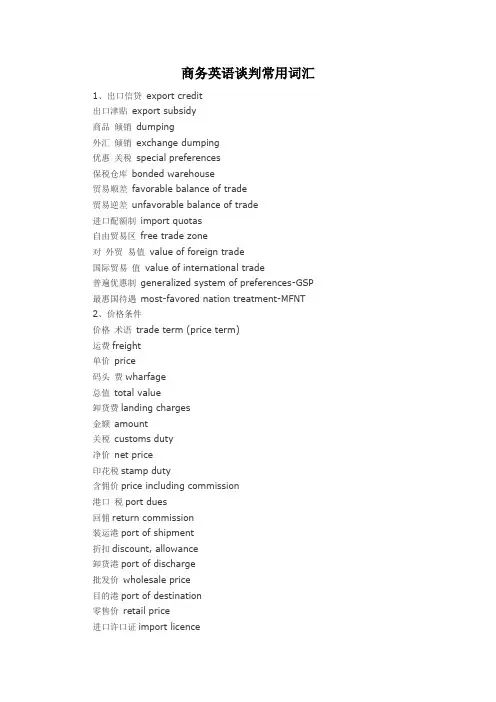
商务英语谈判常用词汇1、出口信贷export credit出口津贴export subsidy商品倾销dumping外汇倾销exchange dumping优惠关税special preferences保税仓库bonded warehouse贸易顺差favorable balance of trade贸易逆差unfavorable balance of trade进口配额制import quotas自由贸易区free trade zone对外贸易值value of foreign trade国际贸易值value of international trade普遍优惠制generalized system of preferences-GSP 最惠国待遇most-favored nation treatment-MFNT 2、价格条件价格术语trade term (price term)运费freight单价price码头费wharfage总值total value卸货费landing charges金额amount关税customs duty净价net price印花税stamp duty含佣价price including commission港口税port dues回佣return commission装运港port of shipment折扣discount, allowance卸货港port of discharge批发价wholesale price目的港port of destination零售价retail price进口许口证import licence现货价格spot price出口许口证export licence期货价格forward price现行价格(时价)current price prevailing price国际市场价格world (International)Market price离岸价(船上交货价) FOB -free on board成本加运费价(离岸加运费价) C&F-cost and freight到岸价(成本加运费、保险费价) CIF -cost,insurance and freight3、交货条件交货delivery轮船steamship(缩写S.S)装运、装船shipment租船charter (the chartered ship)交货时间time of delivery定程租船voyage charter装运期限time of shipment定期租船time charter托运人(一般指出口商)shipper, consignor收货人consignee班轮regular shipping liner驳船lighter舱位shipping space油轮tanker报关clearance of goods陆运收据cargo receipt提货to take delivery of goods空运提单airway bill正本提单original B\\L选择港(任意港)optional port选港费optional charges选港费由买方负担optional charges to be borne by the Buyers 或optional charges for Buyers’ account一月份装船shipment during January 或January shipment一月底装船shipment not later than Jan.31st.或shipment on or before Jan.31st.一/二月份装船shipment during Jan./Feb.或Jan./Feb. shipment在......(时间)分两批装船shipment during....in two lots在......(时间)平均分两批装船shipment during....in two equal lots分三个月装运in three monthly shipments分三个月,每月平均装运in three equal monthly shipments立即装运immediate shipments即期装运prompt shipments收到信用证后30天内装运shipments within 30 days after receipt of L/C 允许分批装船partial shipment not allowed partial shipment not permitted partial shipment not unacceptable4、交易磋商、合同签订订单indent订货;订购book; booking电复cable reply实盘firm offer递盘bid; bidding递实盘bid firm还盘counter offer发盘(发价) offer发实盘offer firm询盘(询价) inquiry;enquiry5、订单indent订货;订购book; booking电复cable reply实盘firm offer递盘bid; bidding递实盘bid firm还盘counter offer发盘(发价) offer发实盘offer firm询盘(询价) inquiry;enquiry6、交易磋商、合同签订指示性价格price indication速复reply immediately参考价reference price习惯做法usual practice交易磋商business negotiation不受约束without engagement业务洽谈business discussion限**复subject to reply **限* *复到subject to reply reaching here **有效期限time of validity有效至**: valid till **购货合同purchase contract销售合同sales contract购货确认书purchase confirmation销售确认书sales confirmation一般交易条件general terms and conditions以未售出为准subject to prior sale需经卖方确认subject to seller’s confirmation需经我方最后确认subject to our final confirmation7、贸易方式INT ( 拍卖auction)寄售consignment招标invitation of tender投标submission of tender一般代理人agent总代理人general agent代理协议agency agreement累计佣金accumulative commission补偿贸易compensation trade (或抵偿贸易)compensating/compensatory trade (又叫:往返贸易) counter trade来料加工processing on giving materials来料装配assembling on provided parts独家经营/专营权exclusive right独家经营/ 包销/代理协议exclusivity agreement独家代理sole agency; sole agent; exclusive agency; exclusive agent8、品质条件品质quality 原样original sample规格specifications 复样duplicate sample说明description 对等样品countersample标准standard type 参考样品reference sample商品目录catalogue 封样sealed sample宣传小册pamphlet 公差tolerance货号article No. 花色(搭配) assortment样品sample 5% 增减5% plus or minus代表性样品representative sample大路货(良好平均品质)fair average quality9、商检仲裁索赔claim 争议disputes罚金条款penalty 仲裁arbitration不可抗力force Majeure 仲裁庭arbitral tribunal产地证明书certificate of origin品质检验证书inspection certificate of quanlity重量检验证书inspection certificate of weight (quantity)**商品检验局**commodity inspection bureau (*.C.I.B)品质、重量检验证书inspection certificate10、数量条件个数number 净重net weight容积capacity 毛作净gross for net体积volume 皮重tare毛重gross weight溢短装条款more or less clause11、外汇外汇foreign exchange 法定贬值devaluation外币foreign currency 法定升值revaluation汇率rate of exchange 浮动汇率floating rate国际收支balance of payments 硬通货hard currency直接标价direct quotation 软通货soft currency间接标价indirect quotation 金平价gold standard买入汇率buying rate 通货膨胀inflation卖出汇率selling rate 固定汇率fixed rate金本位制度gold standard 黄金输送点gold points铸币平价mint par 纸币制度paper money system国际货币基金international monetary fund黄金外汇储备gold and foreign exchange reserve汇率波动的官定上下限official upper and lower limits of fluctuation。
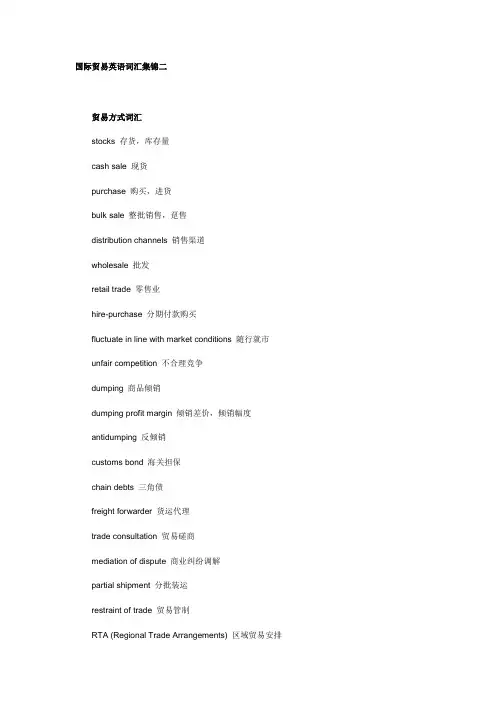
国际贸易英语词汇集锦二贸易方式词汇stocks 存货,库存量cash sale 现货purchase 购买,进货bulk sale 整批销售,趸售distribution channels 销售渠道wholesale 批发retail trade 零售业hire-purchase 分期付款购买fluctuate in line with market conditions 随行就市unfair competition 不合理竞争dumping 商品倾销dumping profit margin 倾销差价,倾销幅度antidumping 反倾销customs bond 海关担保chain debts 三角债freight forwarder 货运代理trade consultation 贸易磋商mediation of dispute 商业纠纷调解partial shipment 分批装运restraint of trade 贸易管制RTA (Regional Trade Arrangements) 区域贸易安排favorable balance of trade 贸易顺差unfavorable balance of trade 贸易逆差special preferences 优惠关税bonded warehouse 保税仓库transit trade 转口贸易tariff barrier 关税壁垒tax rebate 出口退税TBT (Technical Barriers to Trade) 技术性贸易壁垒贸易伙伴术语trade partner 贸易伙伴manufacturer 制造商,制造厂middleman 中间商,经纪人dealer 经销商wholesaler 批发商retailer, tradesman 零售商merchant 商人,批发商,零售商concessionaire, licensed dealer 受让人,特许权获得者consumer 消费者,用户client, customer 顾客,客户buyer 买主,买方carrier 承运人consignee 收货人进出口贸易词汇commerce, trade, trading 贸易inland trade, home trade, domestic trade 国内贸易international trade 国际贸易foreign trade, external trade 对外贸易,外贸import, importation 进口importer 进口商export, exportation 出口exporter 出口商import licence 进口许口证export licence 出口许口证commercial transaction 买卖,交易inquiry 询盘delivery 交货order 订货make a complete entry 正式/完整申报bad account 坏帐Bill of Lading 提单marine bills of lading 海运提单shipping order 托运单blank endorsed 空白背书endorsed 背书cargo receipt 承运货物收据condemned goods 有问题的货物catalogue 商品目录customs liquidation 清关customs clearance 结关**********************************************************对外贸易常用英语(1)They mainly trade with Japanese firms.他们主要和日本商行进行贸易。
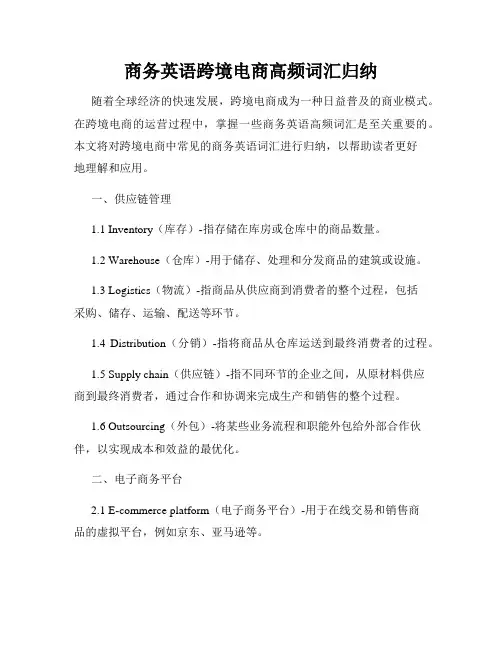
商务英语跨境电商高频词汇归纳随着全球经济的快速发展,跨境电商成为一种日益普及的商业模式。
在跨境电商的运营过程中,掌握一些商务英语高频词汇是至关重要的。
本文将对跨境电商中常见的商务英语词汇进行归纳,以帮助读者更好地理解和应用。
一、供应链管理1.1 Inventory(库存)-指存储在库房或仓库中的商品数量。
1.2 Warehouse(仓库)-用于储存、处理和分发商品的建筑或设施。
1.3 Logistics(物流)-指商品从供应商到消费者的整个过程,包括采购、储存、运输、配送等环节。
1.4 Distribution(分销)-指将商品从仓库运送到最终消费者的过程。
1.5 Supply chain(供应链)-指不同环节的企业之间,从原材料供应商到最终消费者,通过合作和协调来完成生产和销售的整个过程。
1.6 Outsourcing(外包)-将某些业务流程和职能外包给外部合作伙伴,以实现成本和效益的最优化。
二、电子商务平台2.1 E-commerce platform(电子商务平台)-用于在线交易和销售商品的虚拟平台,例如京东、亚马逊等。
2.2 Marketplace(电商市场)-在线平台,允许不同卖家在同一平台上销售商品,例如阿里巴巴国际站、eBay等。
2.3 B2B(Business-to-Business)-指企业之间进行的电子商务活动,例如供应商与制造商之间的交易。
2.4 B2C(Business-to-Consumer)-指企业与消费者之间进行的电子商务交易,例如在网上商城购买商品。
2.5 C2C(Consumer-to-Consumer)-指消费者之间进行的电子商务活动,例如通过在线拍卖网站进行二手商品的交易。
2.6 E-payment(电子支付)-通过网上银行、支付宝等电子渠道进行的支付方式,方便快捷。
三、国际贸易3.1 Import(进口)-从其他国家购买商品并引入本国市场。
3.2 Export(出口)-将本国商品销售给其他国家的过程。
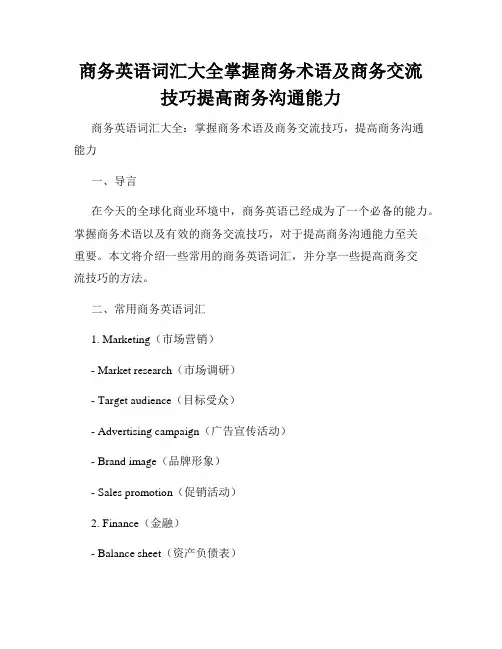
商务英语词汇大全掌握商务术语及商务交流技巧提高商务沟通能力商务英语词汇大全:掌握商务术语及商务交流技巧,提高商务沟通能力一、导言在今天的全球化商业环境中,商务英语已经成为了一个必备的能力。
掌握商务术语以及有效的商务交流技巧,对于提高商务沟通能力至关重要。
本文将介绍一些常用的商务英语词汇,并分享一些提高商务交流技巧的方法。
二、常用商务英语词汇1. Marketing(市场营销)- Market research(市场调研)- Target audience(目标受众)- Advertising campaign(广告宣传活动)- Brand image(品牌形象)- Sales promotion(促销活动)2. Finance(金融)- Balance sheet(资产负债表)- Profit and loss statement(损益表)- Investment(投资)- Return on investment(投资回报率)- Financial forecast(财务预测)3. Human Resources(人力资源)- Recruitment(招聘)- Employee benefits(员工福利)- Performance evaluation(绩效评估)- Training and development(培训和发展)- Employee retention(员工保留)4. International Trade(国际贸易)- Import/export(进出口)- Customs clearance(海关通关)- Tariffs(关税)- Trade deficit(贸易逆差)- Free trade agreement(自由贸易协定)5. Negotiation(谈判)- Bargaining power(谈判力量)- Win-win situation(双赢局面)- Concession(让步)- Counteroffer(还价)- Agreement(协议)三、提高商务交流技巧1. 学习商务英语基础知识- 注册商务英语培训课程- 阅读商务英语教材,掌握基本的商务词汇和句型- 刷题练习商务英语试题,提高词汇理解和运用能力2. 与外籍商务伙伴进行实践交流- 寻找机会参加国际商务活动- 参与商务会议和展览,与外籍商务伙伴进行交流- 参加商务社交活动,扩展人脉和商务关系3. 提升听力和口语交流能力- 听商务英语广播和播客,提高听力理解能力- 多与他人进行商务讨论和演讲,提高口语表达能力- 面对镜子练习商务演讲和谈判技巧4. 阅读商务资讯和案例分析- 阅读商务期刊、报纸和网站,了解最新的商务趋势和信息- 阅读商务案例分析,学习他人的成功经验和策略5. 使用技术工具提高商务交流效率- 学习使用电子邮件、即时通讯和视频会议工具- 掌握商务软件和应用程序,提高工作效率和准确性- 关注社交媒体上的商务英语学习资源和讨论四、结语通过掌握常用的商务英语词汇和运用有效的商务交流技巧,我们能够提高商务沟通能力,更好地适应全球商业环境的挑战。
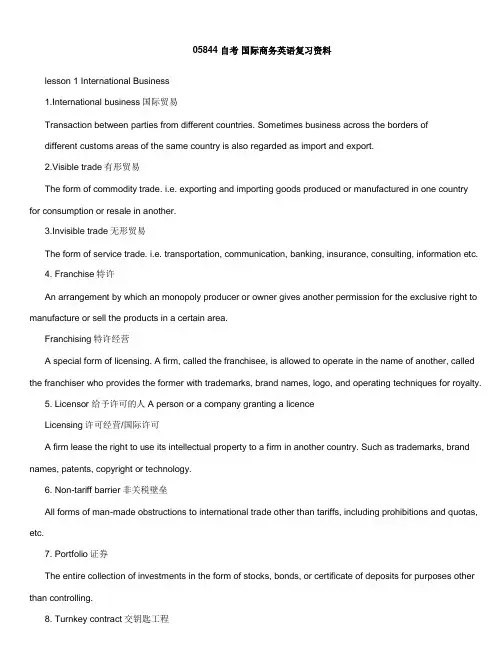
05844 自考国际商务英语复习资料lesson 1 International Business1.International business国际贸易Transaction between parties from different countries. Sometimes business across the borders ofdifferent customs areas of the same country is also regarded as import and export.2.Visible trade有形贸易The form of commodity trade. i.e. exporting and importing goods produced or manufactured in one countryfor consumption or resale in another.3.Invisible trade无形贸易The form of service trade. i.e. transportation, communication, banking, insurance, consulting, information etc.4. Franchise特许An arrangement by which an monopoly producer or owner gives another permission for the exclusive right to manufacture or sell the products in a certain area.Franchising特许经营A special form of licensing. A firm, called the franchisee, is allowed to operate in the name of another, called the franchiser who provides the former with trademarks, brand names, logo, and operating techniques for royalty.5. Licensor 给予许可的人A person or a company granting a licenceLicensing许可经营/国际许可A firm lease the right to use its intellectual property to a firm in another country. Such as trademarks, brand names, patents, copyright or technology.6. Non-tariff barrier非关税壁垒All forms of man-made obstructions to international trade other than tariffs, including prohibitions and quotas, etc.7. Portfolio证券The entire collection of investments in the form of stocks, bonds, or certificate of deposits for purposes other than controlling.8. Turnkey contract交钥匙工程One in which one of the parties agree to supply, at the contract price, a complete product ready for use, such as a new home, factory, ship, etc.9. Contract manufacturing承包生产A firm can concentrate on their strongest part in the value chain.11. Major differences between international business and domestic business.Ans: Differences in (1) legal system (2) currencies(3) cultural background:language, customs, traditions, religion, value, behavior etc.(4) natural and economic conditions,12. Major types of international businessAns: (1) trade : A. commodity trade B. service trade(2) Investment :(difference)A. foreign direct investment (FDI外国直接投资)(is made for returns through controlling the enterprises or assets invested in in a host country.)B. portfolio investment 证券投资(refers to purchases of foreign financial assets for a purpose other than controlling.)(3) other types: A. licensing & franchising(in comparison with the relation between the licenser and licensee, franchiserhas more control over and provide more support for the franchisee.)B. management contract &contract manufacturingC. turnkey project & BOT(making profit from operating the project for a period )13. Why do firms choose licensing as a means of entering a foreign market? Ans:(1) do not have to make cash payments to start business ;(2) receive income in the form of royalty;(3) benefit from locational advantages of foreign operation without any obligations in ownership ormanagement.14. Under what condition is management contract most applicable? Ans: When a government forbids foreign ownership in certain industries it considers tobe of strategic importance but lacks the expertise for operation. A foreign companyto operate in the industry without owning the assets.Lesson 2 Income Level and the World Market1. PPP购买力平价--purchasing power parityPurchasing power购买力 of persons, the public, having the money to buy goods and services.2.Recipient接受者 a person or an organization etc. that receives something.3. Infrastructure基础设施large-scale public services, such as water and power supplies, road, rail and radio communications,etc. Needed to support economic activity, esp.industry, trade and commerce.4. GNP---refer to the market value of goods and services produced by the property andlabor owned by the resident of an economy.(国民生产总值)(focuses on ownership of the factors of production)GDP---refer to the market value of all goods and services produced within thegeographic area of an economy.(国内生产总值)(concentrates on the place where production take place),5. Countries of the world are divided by the World Bank into 3 categories:(1) high-income countries (per capita income of $9,386 and above):A. OECD (the Organization for Economic Cooperation and Development)B. Rich oil producing countries of the Middle East (Kuwait, Saudi Arabia &Arab Emirates)C. Small-industrialized countries or regions (Israel, Singapore, HK and Taiwan)(2) middle-income countries (per capita income bellow $9,386 but above $765 )A. 6 OECD members ( Czech, Greece, Hungary, Mexico and Turkey )B. -a. Some Latin American countries-b. Some Asia countries (China, Indonesia, Malaysia, the Philippines and Thailand)-c. Some South African and oil-producing countries (Libya, Nigeria, Algeria)(3) low-income countries (per capita incomes of only $765 or even less)Include: most African countries, some Asia countries and a few Latin American countries.6. High-income countries often have :(1)good infrastructure (2)high purchasing power (3)advanced technology(4)efficient management(5)favorable environment for trade and investmentA. Offer prime markets for expensive consumer goodsB. Are both attractive sources and destinations of investment7. Low-income countries should not be neglected in international business activities:(1) lower-priced staple goods (2) cheap labor(3) are often rich in resources (4)market is something to be developed8. In what way, GDP&per capita income significant in assessing(评估)the potential of aparticular market:(1)GDP is important in market assessment for durable equipment耐用设备or bulk goods大宗货物, such as grain谷物, steel, or cement水泥. (indicates the overall size of an economy)(2)Per capita income is important when marketing consumer durables.(reveals the average incomelevel of consumers)9. China with a per capita income of over $1,100 is a middle-income countriesthough is was a low income countries just a few years ago.10. The best policy for China to develop business opportunities iswherever advantageous while keeping in mind the key markets.11. Triad ---refers to the 3 richest region of the world ( the United States, the EU and Japan).Quad- --extend the scope of Triad to include Canada and name the broadenedgrouping Quad.12.OECD (the Organization for Economic Cooperation and Development)经济合作发展组织headquarters in Paris, established in 1963, have 29members (23members are high-income countries& 6 middle-income countries).Lesson 3 Regional Economic Intergration1. Major objective of regional integrationTo better enjoy the benefit of free flow of goods, services, capital, labor and other resources, countries have signed various agreement to liberalize trade among themselves while putting up barriers toeconomic activities with non-members.,2. The characteristics of a common market(1)Free trade area自由贸易区members of a free trade removes barriers to the flow of goods and services among themselves while each member still adopts its own policy as regards to trade with outsiders.(different members may have different tariff rates or quota restrictions.)The most notable(largest market)free trade area is NAFTA (the North American Free Trade Agreement), formed by the United Stated, Canada, Mexico in 1991.(2)Customs union 关税同盟by adopting(采取)the same trade policy for all members toward countries outside their organization in addition to abolishing(废除)trade barriers among themselves.(It's impossible for non-members to get into the market of the customs union in a detour(以迂回方式)as they possibly do in the case of trade with a free trade area.)(3)Common market共同市场the European Community remained a common market for some years in the pastA. Free movement of goods and servicesB. Adoption of common external trade policyC. Free movement of the factor of production (such as labor, capital, and technology)It's hard to say individual members will always benefit, still less to expect them to enjoy the advantage of factor mobility to the same degree.(4)Economic union 经济同盟A. is characterized by integration of the domestic policies of its members in respect of economy,finance etc. in addition to absence of trade barriers, practice of common external policy and freeproduction factor mobility.(not only to harmonize their taxation, government expenditure, industry policies,etc.but also use the same currency. )B. the member countries are require to surrender some of their national sovereignty, which is erodingthe tradition of the world political system based on the autonomy and supreme power of sovereign states.3. The development of EU(the European Union)欧盟:1952---ECSC (the European Coal and Steel Community)For more ambitious integration efforts.1957---EEC (the European Economic Community)Treaty of Rome ---signedAim to realizing the free movement of goods, services, labor and capital as well asharmonization of economic policies of the member countries.1967---EC (the European community)became a ture common market as evisaged by --the Single European Actformed by emrging EEC, ECSC and EURATOM(the European Atomic Energy Community)1994---EU--the strength of the Maastricht Treaty---12members(6signatories of the Treaty of Rome :France, Germany, Italy, Belgium, Netherlands and Luxemburg +1973. Britain, Island and Denmark + 1981. Greece + 1986.Spain and Portugal)1995---15members (+Austria, Finland and Sweden)1999---use the common European currency for accounting and settlement2002---euro banknotes and coin were put into circulation.,4. The EU is a full-fledged(齐全的) entity.---composed of 20commissioners overseeing 23departments in charge of different affairs.---the commissioners appointed by member governments, but the commissioners are responsible tothe Union instead of their home country.(1)The Council of Ministers is the most powerful institution.A. has the final say on all important mattersB. has the power to pass legislationC. decision are made by votes allocated to member countries on the basis of their size.D. different ministers attend the council meetings depending on the matters discussed.(2)The European Parliament is an advisory body with limited power.A. vote EU membership application and trade agreements with non-members.B. believed that will be more powerful in the future.5. APEC(the Asia-Pacific Economic Cooperation) 亚太经合组织set up at the Ministerial Meeting held in Australian capital Canberra. 1991,attended by 12members.(1) 21members:all the major Pacific Rim countries and regions.(2) has a five-layer organization structureA. the Informal Meeting of Economic leaders---held annuallyB. the Dual-Ministerial Meeting ---attended by foreign ministers and ministers in chargeof foreign trade (excluding Chinese Taipei and HK)C.the Meeting for Ministers Responsible for TradeD.the Senior Officials Meetings(SOM)--attended by vice ministers, departmental directors or ambassadors to implement(执行) decisions by economicleaders and ministerial meeting.E.four subordinate committees under SOMmittee of Trade and Investmentb.Economic Committeec.Economic and Technical Cooperation Subcommittee of SOMd.Budget Management Committee(3)the tenet and objectives---(by the Seoul Declaration)" inter-dependence, mutual benefits, adhering to an open and multilateral trading system andreduction of regional trade barriers."(4)"the two wheels of APEC"(APEC co-operation concentrates on)A. trade and investment liberation and facilitation (TILF)B. economic and technical cooperation (ECOTECH)6.OPEC(the Organization of Petroleum Exporting Countries)欧佩克--the most influential commodity cartel(account for 40%of the global oil production)(1)composed of 13members established in 1960 with headquarters at Vienna.(2)tried to limit the overall crude oil supply(原油供应) of the world for the purpose of maintaining higher oil prices.,Lesson 4 Economic Globalization1. Economic Globalization经济全球化 as a objective trend(1)The basic featurefree flow of commodity, capital, technology, service, :and information in the context for optimized allocation优化配置Major role:A. Giving new impetus动力 and providing opportunities to world economic development.B. Making the various economies more and more interdependent相互依赖and interactive相互影响.(2)The pros and cons: different countries and peoples do not enjoy balanced benefitsA. enables countries benefit from the boom of other countriesB. makes them more vulnerable to the adverse events across the globe.the best policy for us isto follow the trend closely, availing 利用the opportunities it offer todevelop ourselves and avoiding its possible impacts.2. Multinational enterprise (MNE)跨国企业A business organization which owns (whether wholly or partly), controls and manages assets, oftenincluding productive resources, in more that one country, through its member companies incorporated 有限公司separately in each of these countries.Each member company is known as a multinational corporation(MNC)跨国公司.(1)If the MNC is established as a result of investments by the MNE, whether through the parent or through another of its already established MNC, it is an affiliate MNC.(2)If the MNC is the original investment corporation,it is known as the parent MNC, normally alsothe international headquarters of the MNE.(3)An MNE may also have various regional or operational headquarters, in addition to itsinternational headquarters.3. The characteristics of MNE(1)enormous size(2)wide geographical spread (play an important role and why?)A. have a wide range of option in terms of decisions in areasB.take advantage of changes in the international economic environmentC.engage in worldwide integrated production and market giving rise to extensive intra-MNE transactions Bcs: in order to the security of its profits, assets, organization and operations.(3) longevity and rapid growth4. Commonly objective of MNE(needs, goals, and roles)(1) profit ---the profits goal represents the basic needs of the MNEs' shareholders(2) securityA.the security in the short-and-long-runB.the security of the MNE's assets and investmentC.the security of other organizational needsa. a favorable business environmentb. supplies of raw materials and other resource inputsc. effective organizational control and managementd. transportation and communicatione. technical improvementsf. employees including managers(3)as vehicles for cross-border transfer of resources,5. The relationship between MNEs &their host countriesHost government can and do wield power over MNCs located within their territories. MNCs areunder the legal jurisdiction of their host governments which can impose various rules, regulations and laws on the MNCs to the extent of nationalizing all their assets.6. 4 types of MNCs---according to their organization and way of operation(1)multi-domestic corporations a group of relatively independent subsidiaries. ---i(2)the global corporations-iews the world market as an integrated whole. --vPower and responsibility are concentrated at the headquarters that manage production and marketing to achieve theeconomies of scale as much as possible.(3)the transnational corporation--aim to achieve both efficiency and flexibility, the activities and resources are integrated in an interdependent network of affiliates.(4)world company--as their national identities are blurred to a large extent. -Very few companies reached this level of internationalization.When such companies increasing and become dominating, the possibility of conflicts among sovereign states may begreatly reduced. Possibly they will be instrumental to the realization of complete globalization.Lesson 5 --6 International Trade1. International trade国际贸易Is defined as the exchange of goods and service produced in one country with those produced inanother.2. Other reasons for international trade:(1)the uneven distribution of natural resources among countries(2)International specialization国际生产专门化A.absolute advantage绝对利益/绝对优势(理论)---holds that a commodity will be produced in the country where it costs least in terms ofresources(capital, land, and labor.)---In reality, it is not rare that one country has no absolute advantage in any commodity.parative advantage比较优势(理论)---holds that even if a country is less efficient than another in the production of both commodity, there is still a basis for mutually beneficial trade.---it can make one country better off好转 without making another worse off恶化.The first country should specialize in the production, and export of the commodity in which its absolute disadvantageis smaller, and import the commodity in which its absolute disadvantage is greater.a.introduced by the English economist David Ricardo.b.not a static静止的 concept.(a)Switzerland--watchmaking (b)the United States--the most up-to-date technology.c.the cornerstone基石 of modern thinking on international trade.3. Primary commodities初级货物those commodities not processed, not only slightly processed, usually farm produce or raw material.3. Other bases for trade among countries(1)patterns of demand(2)economy of scale(i.e. The cost advantage of large-scale production)The cost for the production will decrease if the goods are produced on a larger scale.(3)innovation or style,4. The theory of international specialization and other bases for trade seeks to answer thequestion:Which countries will produce what goods, with what trade patterns among them.5. The reasons for complete specialization may never occur(1)for strategic or domestic reasons.a country may continue to produce goods for which does not have an advantage.(2)affected by transport cost.( the cost of transport reduces the benefit of trade,like bulky or perishable goods)(3)protectionist measures which are often taken by governments.6.Tariff barriers关税壁垒---are the most common form of trade restriction.7.Tariff关税---is a tax levied on a commodity when it crosses the boundary of a customs area.8.customs area关税区---usually coincides with the area of a country.9.customs union关税同盟---is a customs area extending beyond national boundaries to include two or more independent nations.10.Import duties进口税--are tariffs levied on goods entering an area.(more common) (1)specificduty--duties levied on the basis of quantity, weight, size etc. of the goods.(2)ad valorem duty--duties levied on the basis of the price of the goods.(3)compound duty--the combination of specific duty&ad valorem duty.11.Export duties出口税--are tariffs levied on goods leaving an area.Coz. Most nations want to expand exports and increasing their foreign exchange earnings.12.drawback退税refers to duties paid on imported goods that are refunded if the goods are reexported.13.MFN(the most-favoured-nation)treatment最惠国待遇refers to a tariff treatment under which a country is required to extend to all signatories any tariffconcessions granted to any participating country.It is not really special but is just normal trading status. It gives a country the lowest tariffs only within the tariff'sschedule, is still possible to have lower tariffs.14.Quotas配额or quantitative restrictions数量限制the most common form of non-tariff barriers.A quota limits the imports or exports of a commodity during a given period of time.The limits may be in quantity or value terms, and quotas may be on a country basis or global, without reference to countries.15.Visible trade--involves the import and export of goods.16.Invisible trade--involves the exchange of services between countries.(1)transportation service运输服务(2)insurance保险(Lloyd's of London is a leading exporter of this service)(3)tourism旅游(4)immigrant remittance移民汇款 ---refers to the money sent back to home countries by people working in a foreign land.,Lesson 7 Incoterms 2000《2000通则》1. The necessity and purpose of having Incoterms(1)eliminate any possibility of misunderstanding and subsequent dispute.(2)to provide a set of international rules for the interpretation of the most commonly used trade termsin foreign trade.2. The revision of Incoterms took account of changes in transportation techniques.3. The 1990 revision of Incoterms was the desire to adapt terms to the increasing use of electronicdata interchange(EDI).It is of vital importance, when using EDI messages, to ensure that the buyer has the same legal position as he wouldhave obtained if he had received a bill of lading from the seller.4. The reasons for the 2000 revision of Incoterms(1)the spread of customs-free zones(2)changes in transportation practices(3)increasing use of electronic communication5.Incoterms 2000E terms---the seller makes the goods available to the buyer at the seller's own premises.(1)EXW---Ex work工厂交货F terms---the seller is called upon to deliver the goods to a carrier appointed by the buyer.(2)FCA---Free Carrier货交承运人(3)FAS---Free Alongside Ship装运港船边交货(4)FOB---Free On Board装运港船上交货C terms--the seller has to contract for carriage, but without assuming the risk of loss of or damage tothe goods or additional costs due to events occurring after shipment and dispatch.(5)CFR---Cost and Freight成本加运费(6)CIF--- Cost, Insurance and Freight成本、保险加运费(7)CPT---Cost Paid To 运费付至(8)CIP---Carriage and Insurance Paid To运费、保险费付至D terms---the seller has bear all costs and risk needed to bring the goods to the country ofdestination.(9)DAF---Delivered At Frontier边境交货(10)DES---Delivered Ex Ship目的港船上交货(11)DEQ---Delivered Ex Quay目的港码头交货(12)DDU---Delivered Duty Unpaid未完税交货(13)DDP---Delivered Duty Paid完税后交货6. The substantive实质性的changes made with Incoterms 2000:(1)the customs clearance and payment of duty obligations under FAS and DEQ.(2)the loading and unloading obligation under FCA.,Lesson 8 Business Contract1.Contract合同is an agreement which sets forth binding obligations of the relevant parties.It is enforceable by law, and any party that fails to fulfill his contractual obligations may be sued andforced to make compensation, though most contract do not give rise to disputes.2.Business negotiation交易磋商: A legitimate contract can be either in written or oral form. (1)Oral---refers to direct discussion conducted:A.at trade affairsB.by sending trade groups abroadC.by inviting foreign customers(2)WrittenA. Enquiry询盘 ---is made without engagement on the part of the enquirer.a. made by the buyers to get information about the goods to be ordered such as quantity,specifications, prices, time of shipment and other terms.b. a first enquiry should be given, so as to facilitate the exporter's work:(a)how the name& address of the exporter have been obtained,(b)the business line and usual practice of the importer.B. Quotation报价---may be sent by the exporter which should include all the necessary informationrequired by the enquiry. Sometimes, the exporter may make an offer to an importer voluntarily. C.Offer and acceptance发盘与接受a firm offer---is a promise to sell goods at a stated price.The validity period is indispensable必不可少的.is open untill a stipulated time or it's accepted or rejected.made of :a. the time of shipmentb.the mode of payment desiredc.an exact description of the goods: quantity, quality, specifications, packing etc. D.Counter-offer还盘---is a refusal of the offer, the offeree may find part of the offer unacceptable and may raise for further discussions his own proposals. (the price, terms of payment, time of shipment, or otherterms and conditions of the offer.)Trade is considered concluded once an offer or a counter-offer is accepted.3. The necessity of the written contractis prepared and signed as the proof of the agreement and as the basis for its execution.4. The types of contracts(1)sales contract--the contract is made by the seller(2)purchase contract--the contract is made by the buyer(3)sales/purchase confirmation--is less detailed than a contact, covering only the essential terms of the transaction. Usually used for smaller deals or between familiar trade partners.5. The setting of a contract(1)the title(2)the contract proper合同正文&address of the buyer and the sellerB.details of the commodity transactionC.terms and conditions mutually agreedD. Indication of the number of original copies, languages used, and the validity. (3)The signatures of the contracting parties(4)the stipulations规定on the back of the contractA.the shipping documents requiredB.force majeureC.arbitration仲裁D.claims理赔,,Lesson 9 Modes of Trade1.counter trade对销贸易--is a peculiar form of transaction allegedly popular in less developed countries and in centrally planned economies. It has become the generic term of describe a set of cross-border contracts that link a seller's exports to imports from the buyer.original:the pre-World War ? years the Reichsbank agreed to establish a clearing system that permitted traditional trade flows between Germany and the Balkans to continue.development:during the World War ?Britain use bilateral arrangements, West Europe setting up the European Payment Union. Subsequently,the countries of centrally planned economies(like Finland)trade credit accounts between familiar trading partners exchanged unrelated goods.In the 1970s and 1980s, counter trade partner are not necessarily familiar partner and goods exchanged are sometimes vertically related.2.The 3forms of counter trade(1)Barter易货贸易The direct exchange of goods and services which is completed in a short period of time.(2)Counter purchase互购贸易An intertemporal不同时的direct exchange of goods and services. Usually stipulated to be fulfilled within a given period of time.(3)Buyback回购贸易/补偿贸易An arrangement by an exporter or plant and equipment to take back in the future part of the output product by these goods as full or partial payment.3.The 2difference between counter purchase and buyback(1)in buyback the goods and services taken back are tied to the original goods exportedbut not in counter purchase.(2)a buyback deal usually stretches over a longer period of time than counter purchase.4.The features common to the 3forms of counter trade is bundling互相捆绑.Bundling--means the exchanges of goods and services are bundled together. (the exchanges are implemented either concurrently同时地or intertemporally不同时地)Unbundling greatly facilitates transaction and allow more efficient economic exchanges.5.The 5advantages in counter trade:(1)helps a country to deal with foreign exchange shortages; (2)promote exports;(3)reduce uncertainty regarding export receipts;(4)bypass an international price agreement(5)helps countries with debt problems to import goods.6.The drawbacks of counter trade:(1)concealing the real prices and costs of transactions . (2)company may suffer losses bcz they could not get rid of products of poor quality. (3)be considered as a form of protectionism.7.Other modes of trade:(1)processing trade加工贸易(2)consignment寄售(3)leasing trade租赁贸易(4)agency代理,,Lesson 10 International Payment1.Mutual trust is hard to build. purchase and sale of goods and service are carried out beyond national boundaries, which makes it rather difficult for the parities concerned in the transaction to。
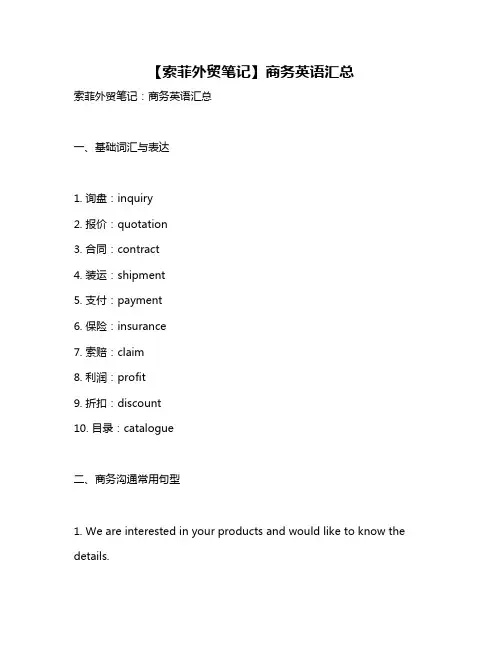
【索菲外贸笔记】商务英语汇总索菲外贸笔记:商务英语汇总一、基础词汇与表达1. 询盘:inquiry2. 报价:quotation3. 合同:contract4. 装运:shipment5. 支付:payment6. 保险:insurance7. 索赔:claim8. 利润:profit9. 折扣:discount10. 目录:catalogue二、商务沟通常用句型1. We are interested in your products and would like to know the details.2. We offer you our best price, considering the market situation.3. Could you please send us your latest catalogues?4. We agree to your terms and conditions.5. We hope to establish a long-term business relationship with you.6. We regret that we cannot accept your claim.7. Please note that our payment terms are strictly net cash against documents.8. We would like to confirm the shipment date with you.9. We have enclosed the invoice for your reference.10. Thank you for your inquiry. We will get back to you soon.三、商务谈判常见话题与技巧1. Pricing: Understanding the market and competitors, determining the optimal price based on product quality and demand.2. Payment terms: Negotiating the best payment method, timeframe, and terms for both parties.3. Delivery: Setting a reasonable delivery date and ensuring timely delivery without compromising on quality.4. Contract terms: Clarifying all terms and conditions, including warranties, liabilities, and dispute resolution mechanisms.5. Branding and marketing: Understanding the target market and devising strategies to promote the products effectively.6. Quality control: Ensuring that products meet the agreed standards and specifications, with regular quality checks during production.7. Compliance with regulations: Staying updated with local laws and regulations to ensure smooth business operations.8. Customer service: Providing excellent customer service post-sales, handling queries and complaints promptly and professionally.9. Upscaling and diversification: Continuously improving products and services, exploring new markets, and diversifying operations to stay ahead of the competition.。
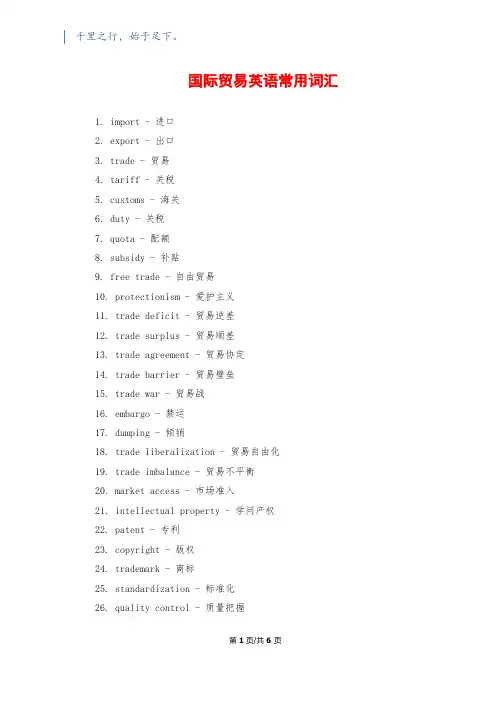
国际贸易英语常用词汇1. import - 进口2. export - 出口3. trade - 贸易4. tariff - 关税5. customs - 海关6. duty - 关税7. quota - 配额8. subsidy - 补贴9. free trade - 自由贸易10. protectionism - 爱护主义11. trade deficit - 贸易逆差12. trade surplus - 贸易顺差13. trade agreement - 贸易协定14. trade barrier - 贸易壁垒15. trade war - 贸易战16. embargo - 禁运17. dumping - 倾销18. trade liberalization - 贸易自由化19. trade imbalance - 贸易不平衡20. market access - 市场准入21. intellectual property - 学问产权22. patent - 专利23. copyright - 版权24. trademark - 商标25. standardization - 标准化26. quality control - 质量把握第1页/共6页27. logistics - 物流28. exchange rate - 汇率29. currency - 货币30. foreign direct investment - 外商直接投资31. multinational corporation - 跨国公司32. supply chain - 供应链33. container - 集装箱34. trade fair - 贸易展览会35. trade mission - 商务访问团36. goods - 商品37. services - 服务38. negotiation - 谈判39. agreement - 协议40. contract - 合同41. invoice - 发票42. payment - 付款43. delivery - 交货44. insurance - 保险45. dispute - 争议46. arbitration - 仲裁47. compliance - 符合48. documentation - 文件49. logistics provider - 物流服务供应商50. transportation - 运输51. export license - 出口许可证52. import license - 进口许可证53. trade finance - 贸易融资54. letter of credit - 信用证55. bill of lading - 提单56. customs clearance - 海关清关57. incoterms - 贸易术语58. CIF - 成本加保险加运费价59. FOB - 离岸价60. EXW - 工厂交货价61. DDP - 目的地交货价62. L/C - 信用证63. T/T - 电汇64. B/L - 提单65. NAFTA - 北美自由贸易协定66. WTO - 世界贸易组织67. ASEAN - 东南亚国家联盟68. EU - 欧洲联盟69. APEC - 亚太经济合作组织70. GATT - 关税和贸易总协定71. World Bank - 世界银行72. IMF - 国际货币基金组织73. developing countries - 进展中国家74. developed countries - 发达国家75. emerging markets - 新兴市场76. market economy - 市场经济77. command economy - 方案经济78. mixed economy - 混合经济79. inflation - 通货膨胀80. recession - 经济衰退81. economic growth - 经济增长82. purchasing power - 购买力83. economic indicators - 经济指标84. GDP - 国内生产总值85. inflation rate - 通货膨胀率第3页/共6页86. unemployment rate - 失业率87. interest rate - 利率88. exchange rate - 汇率89. stock market - 股市90. commodity - 商品91. consumer goods - 消费品92. capital goods - 生产资料93. raw materials - 原材料94. agricultural products - 农产品95. energy resources - 能源资源96. manufacturing - 制造业97. agriculture - 农业98. services sector - 服务业99. technology - 技术100. innovation - 创新101. demand - 需求102. supply - 供应103. market - 市场104. price - 价格105. cost - 成本106. profit - 利润107. competition - 竞争108. market share - 市场份额109. marketing - 市场营销110. branding - 品牌建设111. advertising - 广告112. promotion - 推销113. distribution - 分销114. consumer - 消费者115. producer - 生产者116. retailer - 零售商117. wholesaler - 批发商118. e-commerce - 电子商务119. online shopping - 网上购物120. market research - 市场调研121. target market - 目标市场122. market segmentation - 市场细分123. product life cycle - 产品生命周期124. branding - 品牌建设125. customer relationship management - 客户关系管理126. business-to-business - 企业对企业127. business-to-consumer - 企业对消费者128. business-to-government - 企业对政府129. supply and demand - 供需关系130. economic sanctions - 经济制裁131. quota system - 配额制度132. foreign exchange - 外汇133. trade deficit - 贸易逆差134. protectionist policy - 爱护主义政策135. foreign investment - 外国投资136. market share - 市场份额137. global market - 全球市场138. economic integration - 经济一体化139. international trade rules - 国际贸易规章140. trade dispute - 贸易纠纷141. trade organization - 贸易组织142. trade policy - 贸易政策143. balance of trade - 贸易平衡144. current account - 经常账户第5页/共6页145. capital account - 资本账户146. foreign exchange rate - 外汇汇率147. interest rate - 利率148. central bank - 中心银行149. monopoly - 垄断150. globalization - 全球化。
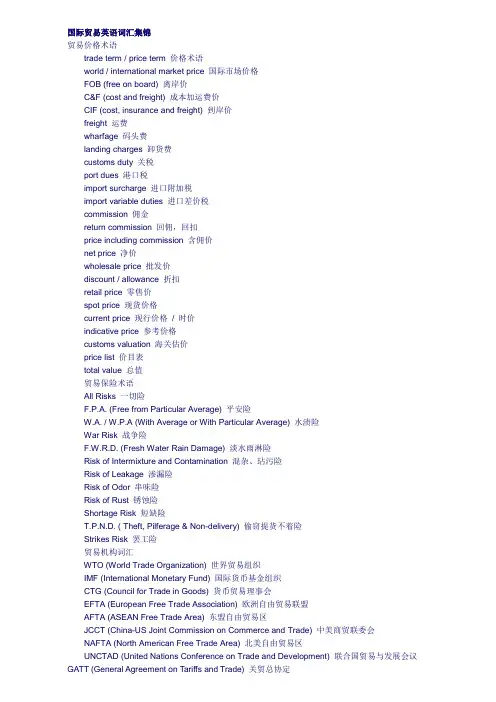
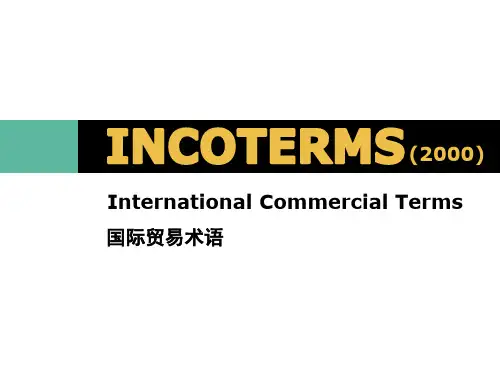
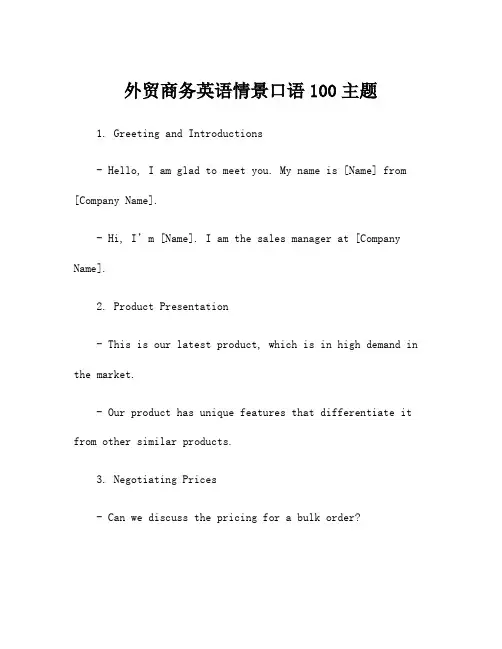
外贸商务英语情景口语100主题1. Greeting and Introductions- Hello, I am glad to meet you. My name is [Name] from [Company Name].- Hi, I’m [Name]. I am the sales manager at [Company Name].2. Product Presentation- This is our latest product, which is in high demand in the market.- Our product has unique features that differentiate it from other similar products.3. Negotiating Prices- Can we discuss the pricing for a bulk order?- We are willing to negotiate the price if the order quantity is increased.4. Shipping and Logistics- How soon can the products be shipped to our warehouse?- We need to make sure the products are delivered on time.5. Payment Terms- What are the payment terms for the order?- We prefer to have a flexible payment arrangement.6. Quality Assurance- Can you assure the quality of the products?- We need to make sure the products meet our quality standards.7. Market Analysis- Can you provide us with a market analysis for the product?- We need to understand the target market for the product.8. Trade Shows and Exhibitions- Are you planning to attend any trade shows or exhibitions?- We are interested in participating in trade shows to promote our products.9. Business Contracts- We need to sign a formal contract for the business agreement.- Let’s review the terms and conditions of the contract.10. Cultural Differences- How can we overcome cultural barriers in doing business?- It is important to understand and respect cultural differences in business.11. Business Etiquette- What are the proper business etiquettes in your country?- We want to ensure that we follow the appropriate business protocols.12. Time Management- How do you manage your time effectively in business?- Time management is crucial for business success.13. Handling Complaints- What is the procedure for handling customer complaints?- We need to address any complaints from customers promptly.14. Building Relationships- Let’s focus on building a long-term business relationship.- Building a good relationship is essential for business growth.15. Ethical Business Practices- We believe in upholding ethical business practices.- It is important to conduct business with integrity and honesty.16. Branding and Marketing- How do you plan to promote your brand in the market?- Branding and marketing are important for business visibility.17. Cross-Cultural Communication- How do you communicate effectively across different cultures?- Understanding cross-cultural communication is essential in international business.18. Supply Chain Management- Can you provide information about your supply chain management?- Effective supply chain management is crucial for business operations.19. E-commerce and Online Sales- How do you utilize e-commerce for your business?- E-commerce has become an important aspect of business today.20. Import and Export Regulations- What are the import and export regulations in your country?- Understanding the regulations is important for international trade.21. Financial Planning- How do you plan your finances for business growth?- Financial planning is crucial for the success of any business.22. Risk Management- How do you mitigate risks in foreign trade business?- Identifying and managing risks is important for business stability.23. Business Networking- Let’s explore opportunities for business networking.- Building a strong network is important for business expansion.24. Taxation and Compliance- What are the tax requirements for foreign trade?- It is important to comply with tax regulations for international business.25. Data Analysis and Decision Making- How do you analyze data to make informed business decisions?- Data analysis is crucial for effective decision-making.26. Product Development and Innovation- How do you focus on product development and innovation?- Continuous improvement is essential for business growth.27. Market Entry Strategies- What are the strategies for entering new markets?- Market entry requires careful planning and strategic approach.28. International Business Law- How do you ensure compliance with internationalbusiness laws?- Understanding international business laws is important for legal protection.29. Environmental Sustainability- What is your approach to environmental sustainabilityin business?- Environmental sustainability is a growing concern in global business.30. Market Research and Analysis- How do you conduct market research and analysis?- Market research is important for understanding consumer needs.31. Customer Relationship Management- How do you manage your relationships with customers?- Building strong customer relationships is important for business retention.32. Trade Financing- Can you provide information on trade financing options?- Trade financing is important for facilitating international transactions.33. Foreign Exchange and Currency Management- How do you manage foreign exchange and currency fluctuations?- Currency management is important for international transactions.34. Outsourcing and Vendor Management- How do you manage your vendors and outsourcing partners?- Effective vendor management is important for business operations.35. Business Intelligence and Analytics- How do you utilize business intelligence and analytics for your business?- Data-driven decision-making is important for business success.36. Diplomacy and Conflict Resolution- How do you handle conflicts and maintain diplomacy in business?- Conflict resolution is important for maintaining good business relationships.37. International Trade Agreements- What are the trade agreements that affect your business?- Understanding trade agreements is important forbusiness planning.38. Regulatory Compliance- How do you comply with regulations in different countries?- Complying with regulations is important for international trade.39. Intellectual Property Rights- How do you protect your intellectual property in foreign trade?- Protecting intellectual property is important for business security.40. Digital Marketing and Social Media- How do you utilize digital marketing and social media for business promotion?- Digital marketing has become an important aspect of business promotion.41. Market Segmentation and Targeting- How do you segment and target your market effectively?- Understanding the target market is important for business success.42. Crisis Management- How do you handle crisis situations in business?- Crisis management is important for business resilience.43. Competitive Analysis- How do you analyze your competitors in the market?- Understanding competition is important for business strategy.44. Regulatory Changes and Updates- How do you stay updated with regulatory changes affecting your business?- Staying informed about regulatory changes is important for compliance.45. Business Continuity Planning- How do you plan for business continuity in case of disruptions?- Business continuity planning is important for risk management.46. Innovation and Technology Adoption- How do you adopt innovation and technology in your business?- Embracing technology is important for business growth.47. Strategic Partnerships and Alliances- How do you form strategic partnerships and alliances for business growth?- Collaborating with partners is important for business expansion.48. Crisis Communication- How do you communicate with stakeholders during a crisis?- Effective communication is crucial during crisis situations.49. Data Privacy and Cybersecurity- How do you ensure data privacy and cybersecurity in your business?- Protecting data and cybersecurity is important for business integrity.50. Talent Acquisition and Human Resources- How do you recruit and manage talent for your business?- Human resources management is important for business operations.51. Business Expansion and Globalization- How do you plan for business expansion in the global market?- Globalization requires careful planning and strategy.52. Sales and Marketing Strategies- What sales and marketing strategies do you implement for your products?- Effective sales and marketing strategies are important for business growth.53. Market Trends and Forecasting- How do you identify and forecast market trends in your industry?- Understanding market trends is important for business planning.54. Export Documentation and Compliance- What are the documentation requirements for export compliance?- Compliance with export documentation is important for international trade.55. Relationship Building with Suppliers- How do you build strong relationships with your suppliers?- Building good supplier relationships is important for business operations.56. Conflict of Interest Management- How do you manage conflicts of interest in business dealings?- Managing conflicts of interest is important for business ethics.57. Business Travel and Communication- How do you handle business travel and communication with international partners?- Effective communication during business travel is crucial for business success.58. Market Entry Challenges- What challenges do you face when entering new markets?- Overcoming market entry challenges requires careful planning and strategy.59. Social Responsibility and Ethical Sourcing- How do you ensure social responsibility and ethical sourcing in your business?- Social responsibility and ethical sourcing are important for business reputation.60. Market Positioning Strategies- How do you position your brand in the market for competitive advantage?- Strategic positioning is important for brand visibility.61. Regulatory Compliance Training- How do you provide regulatory compliance training toyour employees?- Training on regulatory compliance is important for business integrity.62. Business Analytics and Key Performance Indicators- How do you utilize business analytics and KPIs to measure business performance?- Monitoring business performance is important for business growth.63. Trade Tariffs and Import Duties- How do you manage trade tariffs and import duties for international trade?- Understanding trade tariffs and import duties is important for cost management.64. Market Penetration and Market Share- How do you penetrate new markets and increase market share?- Market penetration and market share growth are important for business expansion.65. International Business Networking Events- How do you leverage international business networking events for your business?- Networking at international events is important for business connections.66. Global Supply Chain Integration- How do you integrate your global supply chain for efficiency?- Supply chain integration is important for business operations.67. Risk Assessment and Risk Mitigation- How do you assess and mitigate risks in your business?- Identifying and managing risks is crucial for business stability.68. Product Packaging and Labeling Compliance- How do you ensure compliance with product packaging and labeling regulations?- Packaging and labeling compliance is important for product distribution.69. Sales Forecasting and Demand Planning- How do you forecast sales and plan for demand in your business?- Sales forecasting and demand planning are important for inventory management.70. International Trade Disputes and Resolutions- How do you handle trade disputes and find resolutions in international trade?- Resolving trade disputes is important for maintaining business relationships.71. Business Process Optimization- How do you optimize your business processes for efficiency?- Process optimization is important for business productivity.72. FDI (Foreign Direct Investment) and Market Entry- How do you attract foreign direct investment and enter new markets?- FDI and market entry strategies are important for business expansion.73. Business Risk Analysis and Contingency Planning- How do you analyze business risks and plan for contingencies?- Contingency planning is important for business resilience.74. International Trade Finance and Letters of Credit- How do you utilize trade finance options and letters of credit for international transactions?- Trade finance and letters of credit are important for trade transactions.75. Market Segmentation and Consumer Behavior- How do you segment markets and understand consumer behavior in different regions?- Understanding consumer behavior is important for marketing strategies.76. Ethical Supply Chain Management- How do you ensure ethical practices in your supply chain management?- Ethical supply chain management is important for business sustainability.77. Business Ethics and Corporate Governance- How do you uphold business ethics and ensure corporate governance in your business?- Promoting ethical business practices is important for business reputation.78. Product Compliance and Regulatory Certifications- How do you ensure product compliance and obtain regulatory certifications?- Products compliance and certifications are important for market access.79. Channel and Distribution Management- How do you manage your channels and distribution networks for effective sales?- Channel and distribution management are important for product distribution.80. International Trade Insurance and Risk Management- How do you utilize trade insurance and manage risks in international trade?- Risk management and insurance are important for business protection.81. Market Development Strategies- How do you develop new markets and identify growth opportunities?- Market development requires strategic planning and analysis.82. Business Fraud Prevention and Detection- How do you prevent and detect business fraud in your operations?- Fraud prevention is important for business security.83. International Business Terminology and Language Skills- How do you improve international business terminology and language skills?- Language skills are important for effective communication in international business.84. Innovation and Research & Development- How do you invest in innovation and research & development for new products?- Innovation and R&D are important for business growth.85. Market Entry Barriers and Market Access- What are the barriers to market entry and how do you gain market access?- Overcoming market entry barriers is important for business expansion.86. Product Recall and Quality Assurance- How do you handle product recalls and ensure quality assurance in your business?- Product quality is important for customer satisfaction and retention.87. Export Compliance and Trade Controls- How do you comply with export regulations and trade controls for international trade?- Export compliance is important for business trust and integrity.88. Channel Partnerships and Collaborations- How do you form channel partnerships and collaborations for business growth?- Collaborating with partners is important for business expansion.89. Competitive Pricing and Value Proposition- How do you set competitive pricing and offer value to your customers?- Value proposition is important for customer attraction and retention.90. Import Licensing and Customs Clearance- How do you obtain import licenses and manage customs clearance for your products?- Import licensing and customs clearance are importantfor product importation.91. Crisis Communication and Media Relations- How do you handle crisis communication and manage media relations during crisis situations?- Effective communication during crises is important for business reputation.92. Supply Chain Risk Management and Resilience- How do you manage supply chain risks and build resilience in your operations?- Resilient supply chain management is important for business stability.93. Rules of Origin and Preferential Trade Agreements- How do you comply with rules of origin and utilize preferential trade agreements for your products?- Preferential trade agreements are important forreducing trade barriers.94. Market Testing and Product Launch- How do you test markets and launch products effectively?- Market testing is important for understanding consumer response.95. Overseas Branches and Business Expansion- How do you establish overseas branches and expand your business internationally?- Overseas expansion requires strategic planning and investment.96. International Payment Terms and Currency Hedging- How do you negotiate international payment terms and manage currency hedging for your transactions?- Currency hedging is important for mitigating financial risks.97. Business Diversity and Inclusion- How do you promote diversity and inclusion in your business?- Embracing diversity and inclusion is important for business reputation.98. International Trade Agreements and Politics- How do international trade agreements and political factors affect your business?- Understanding political influences is important for business planning.99. Supply Chain Transparency and Traceability- How do you ensure supply chain transparency and traceability in your operations?- Transparency and traceability are important for product integrity.100. Exit Strategies and Business Closure- How do you plan exit strategies and manage business closure if needed?- Planning for business closure is important for risk management.。
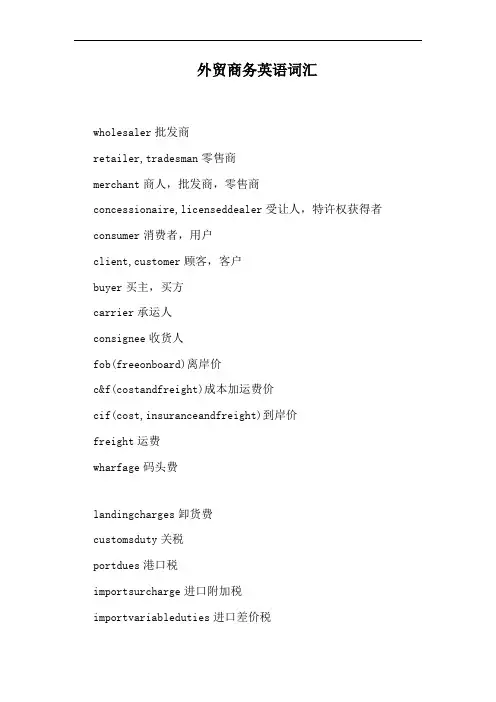
外贸商务英语词汇wholesaler批发商retailer,tradesman零售商merchant商人,批发商,零售商concessionaire,licenseddealer受让人,特许权获得者consumer消费者,用户client,customer顾客,客户buyer买主,买方carrier承运人consignee收货人fob(freeonboard)离岸价c&f(costandfreight)成本加运费价cif(cost,insuranceandfreight)到岸价freight运费wharfage码头费landingcharges卸货费customsduty关税portdues港口税importsurcharge进口附加税importvariableduties进口差价税commission佣金returncommission回佣,回扣priceincludingcommission含佣价netprice净价wholesaleprice批发价discount/allowance折扣retailprice零售价spotprice现货价格currentprice现行价格/时价indicativeprice参考价格customsvaluation海关估价pricelist价目表totalvalue总值贸易保险术语allrisks一切险f.p.a.(freefromparticularaverage)平安险w.a./w.p.a(withaverageorwithparticularaverage)水渍险warrisk战争险f.w.r.d.(freshwaterraindamage)淡水雨淋险riskofintermixtureandcontamination混杂、玷污险riskofleakage渗漏险riskofodor串味险riskofrust锈蚀险shortagerisk短缺险t.p.n.d.(theft,pilferage&non-delivery)偷窃提货不着险strikesrisk罢工险贸易机构词汇wto(worldtradeorganization)世界贸易组织imf(internationalmonetaryfund)国际货币基金组织ctg(councilfortradeingoods)货币贸易理事会efta(europeanfreetradeassociation)欧洲自由贸易联盟afta(aseanfreetradearea)东盟自由贸易区jcct(china-usjointcommissiononcommerceandtrade)中美商贸联委会nafta(northamericanfreetradearea)北美自由贸易区unctad(unitednationsconferenceontradeanddevelopment)联合国贸易与发展会议gatt(generalagreementontariffsandtrade)关贸总协定stocks存货,库存量cashsale现货purchase购买,进货bulksale整批销售,趸售distributionchannels销售渠道wholesale批发retailtrade零售业hire-purchase分期付款购买fluctuateinlinewithmarketconditions随行就市unfaircompetition不合理竞争dumping商品倾销dumpingprofitmargin倾销差价,倾销幅度antidumping反倾销customsbond海关担保chaindebts三角债freightforwarder货运代理tradeconsultation贸易磋商mediationofdispute商业纠纷调解partialshipment分批装运restraintoftrade贸易管制rta(regionaltradearrangements)区域贸易安排favorablebalanceoftrade贸易顺差unfavorablebalanceoftrade贸易逆差specialpreferences优惠关税bondedwarehouse保税仓库transittrade转口贸易tariffbarrier关税壁垒taxrebate出口退税tbt(technicalbarrierstotrade)技术性贸易壁垒commerce,trade,trading贸易inlandtrade,hometrade,domestictrade国内贸易internationaltrade国际贸易foreigntrade,externaltrade对外贸易,外贸import,importation进口importer进口商export,exportation出口exporter出口商importlicence进口许口证exportlicence出口许口证commercialtransaction买卖,交易inquiry询盘delivery交货order订货makeacompleteentry正式/完整申报badaccount坏帐billoflading提单marinebillsoflading海运提单shippingorder托运单blankendorsed空白背书endorsed背书cargoreceipt承运货物收据condemnedgoods有问题的货物catalogue商品目录customsliquidation清关customsclearance结关tradepartner贸易伙伴manufacturer制造商,制造厂middleman中间商,经纪人dealer经销商。
ship from商务英语全文共四篇示例,供读者参考第一篇示例:ship from商务英语是指在商务交易中的一种发货方式,即由卖方通过船运将货物发往买方所在地的一种方式。
在国际贸易中,ship from商务英语是非常常见的一种运输方式,尤其是在跨国贸易中更是被广泛应用。
下面我们就来详细了解一下ship from商务英语的相关知识。
对于ship from商务英语中的相关术语,还有一些需要了解的内容。
FOB(Free on Board)是国际贸易中常用的术语,表示卖方将货物交付给装运船公司后所产生的所有费用和风险由卖方承担,直到货物穿过船舷为止。
CIF(Cost, Insurance and Freight)是另一种常见的国际贸易术语,表示卖方负责将货物送达目的港口并承担货物在运输途中的运费和保险费。
对于ship from商务英语的重要性,可以说是非常重要的。
在国际贸易中,货物的运输方式直接影响着交易的成本和效率。
选择合适的运输方式和合作的物流公司对于双方都是非常有利的。
通过ship from 商务英语的应用,可以确保货物按时、按量到达目的地,有利于双方建立长期而稳定的合作关系。
ship from商务英语在国际贸易中扮演着非常重要的角色。
掌握这些相关知识可以帮助我们更好地理解和应用这种运输方式,从而提高商务交易的效率和顺利进行。
希望以上内容能够帮助大家更加深入地了解ship from商务英语,为国际贸易中的交易提供更好的支持和指导。
第二篇示例:Ship from商务英语是指国际贸易中涉及到货物从供应商所在国家或地区发出运往目的国家或地区的一种贸易方式。
在这种贸易过程中,卖方或供应商要负责货物从出发国到目的国的运输,包括物流、海运、空运等环节。
ship from商务英语是国际贸易中非常重要的一部分,涉及到多方合作和各种交流。
在ship from商务英语中,流程包括以下几步骤:1. 询盘:买方在需要货物的时候向卖方发送询价单或询盘,询问货物的价格、数量、交货期等细节。
常见商务缩写A.R-------------All Risks 一切险ANER 亚洲北美东行运费协定Asia North America Eastbound Rate AWB:airway bill 空运提单ATTN------------attentiona/c----------------account no.AWB-------------airway billB组B.D.I-------------------Both Days Inclusive 包括头尾两天BAF 燃油附加费Bunker Adjustment FactorBAF 燃油附加费,大多数航线都有,但标准不一。
B/L 海运提单Bill of LadingB/ldg.--------------------B/L Bill of Lading 提单Bs/L----------------------Bills of Lading 提单(复数)B/R 买价Buying RateBal.----------------------Balance 差额bar. or brl.--------------barrel 桶;琵琶桶B.B. clause---------------Both to blame collision clause 船舶互撞条款B/C-----------------------Bills for collection 托收单据B.C.----------------------before Christ 公元前b.d.----------------------brought down 转下B.D.----------------------Bank draft 银行汇票Bill Discounted--------- 贴现票据b.d.i.--------------------both dates inclusive 包括首尾两日bdle. ;bdl.--------------bundle 把;捆b.e. ;B/E ; B. EX.-------Bill of Exchange 汇票B.f.----------------------Brought forward 接下页B/G-----------------------Bonded goods 保税货物bg. ;b/s-----------------bag(s)袋bkg.----------------------backing 银行业务bkt.----------------------basket 篮;筐bl.;bls.-----------------bale(s)包Blading-------------------Bill of Lading 提单bldg.---------------------building 大厦bls.----------------------Bales 包,barrels 桶bot. ;bott. ;btl--------bottle 瓶br.-----------------------brand 商标;牌Brkge.--------------------breakage 破碎brls.---------------------barrels 桶;琵琶桶b/s-----------------------bags;bales 袋;包btl.----------------------bottle 瓶bu.-----------------------bushel 蒲式耳bx.-----------------------box 箱bxs.----------------------boxes 箱(复数),盒(复数)Bal.-----------------------Ballance 余额C组CFR 成本加运费(……指定目的港)CFR(cost and freight)成本加运费价C&F(成本加运费):COST AND FREIGHTC&F 成本加海运费COST AND FREIGHTCIF 成本、保险费加运费付至(……指定目的港)CIF 成本,保险加海运费COST,INSURANCE,FRIGHTCIF(成本运费加保险,俗称“到岸价”):COST INSURANCE AND FREIGHT CPT 运费付至(……指定目的港)CPT 运费付至目的地Carriage Paid ToCIP 运费、保险费付至(……指定目的地)CIP 运费、保险费付至目的地Carriage and Insurance Paid ToCOD:cash on delivery/collect on delivery 货到付款CCA:current cost accounting 现实成本会计Contract change authorization 合同更改批准Changed carriage advice 变更货运通知CY/CY 整柜交货(起点/终点)C.Y. 货柜场Container YardCY(码头):CONTAINER YARDCFS(场):CARGO FREIGHT STATIONC/D (customs declaration)报关单C.C.(运费到付):COLLECTC.C 运费到付CollectC.C.O.V 价值,产地联合证明书CCPIT 中国国际贸易促进委员会CNTR NO. (柜号):CONTAINER NUMBERC.O (certificate of origin)一般原产地证CTN/CTNS(carton/cartons)纸箱C.S.C 货柜服务费Container Service ChargeC/(CNEE)收货人ConsigneeC/O 产地证Certificate of OriginCAF 货币汇率附加费Currency Adjustment FactorCFS 散货仓库Container Freight StationCFS/CFS 散装交货(起点/终点)CHB 报关行Customs House BrokerCOMM 商品CommodityCTNR 柜子Containerc/- (or c/s)---------------cases 箱ca.;c/s;cs.--------------case or cases 箱C.A.D.;C/D----------------cash against documents 付款交单C.A.F.---------------------Cost,Assurance,Freight---------------------------(=C.I.F.)成本加保费. 运费价canc.----------------------cancel,cancelled,cancellation取消;注销cat.-----------------------catalogue 商品目录C/B------------------------clean bill 光票C.B.D.---------------------cash before delivery 先付款后交单c.c.-----------------------cubic centimetre 立方厘米;立方公分c.c.-----------------------carbon copy 复写纸;副本(指复写纸复印的)C.C.-----------------------Chamber of Commerce 商会C.C.I.B.-------------------China Commodity Inspection Bureau 中国商品检验局C/d------------------------carried down 转下cent-----------------------centum(L.)一百Cert. ;Certif.------------certificate ;certified 证明书;证明c.f.-----------------------Cubic feet 立方英尺C/f------------------------Carried forward 接后;结转(下页)cf.------------------------confer 商议;Compare 比较CFS; C.F.S.----------------Container Freight Station 集装箱中转站;货运站C.G.A.---------------------Cargo''s proportion of General Average 共同海损分摊额cgo.-----------------------cargo 货物chges.---------------------charges 费用Chq.-----------------------Cheque支票C.I.-----------------------Certificate of Insurance 保险凭证;---------------------------Consular Invoice 领事发票;领事签证C.I.F. & C.----------------Cost insurance Freight & Commission 成本. 保险费加运费. 佣金价格C.I.F. & E.----------------Cost Insurance Freight & Exchange 成本. 保险费. 运费加汇费的价格C.I.F. & I-----------------Cost Insurance Freight & Interest 成本. 保险费. 运费加利息的价格C.I.O.---------------------Cash in Order;Cash with order 订货时付款cks.-----------------------casks 桶cl.------------------------class;clause 级;条款;项CLP------------------------Container Load Plan 集装箱装箱单cm-------------------------centimetre 厘米;公分cm2------------------------square centimetre 平方厘米;平方公分cm3------------------------cubic centimetre 立方厘米;立方公分CMB------------------------国际公路货物运输条约c/n------------------------cover note 暂保单;预保单CNC------------------------新集装箱运输Co.------------------------Company 公司c/o------------------------care of 转交C/O ; c.o.-----------------Certificate of origin 产地证明书c.o.d. ,C.O.D.-------------Cash on delivery or Collection delivery 货到付款COFC-----------------------Container on Flat Car 平板车装运集装箱Com.-----------------------Commission 佣金Con.inv.-------------------Consular invoice 领事签证发票Cont. ;Contr.-------------Contract 合同;合约Contd.---------------------Continued 继续;续(上页)Contg.---------------------containing 内容Corp. ;Corpn. ;cor.------corporation 公司;法人C/P ; c. py.---------------charter party 租船契约C.Q.D.---------------------Customary Quick Despatch 按习惯速度装卸Cr.------------------------Credit 贷方;信用证;Creditor 债权人Crt.-----------------------crate 板条箱Ct.------------------------Cent 人;Current 当前;目前Credit---------------------贷方;信用证C.T.D.---------------------Combined transport document 联合运输单据CT B/L---------------------Combined transport bill of Iading 联合运输提单C.T.O.---------------------Combined transport operator 联合运输经营人cu. cm. ;cb. cm-----------cubic centimetre 立方厘米;立方公分cu. in. ;cb. in.----------cubic inch 立方寸cu.m. ;cb. m.-------------cubic metre 立方米;立方公尺cu.ft. ;cb.ft.------------cubic foot 立方英尺cur. ;---------------------Curt current (this month)本月cur.-----------------------currency 币制cu.yd. ;cb. yd.-----------cubic yard 立方码C.W.O.---------------------cash with order 订货时付款c.w.t. ;cwt.--------------hundredweight 英担(122磅)CY-------------------------Container Yard 集装箱堆场D组DDU:delivery duty unpaid 未完税交货DDP:delivery duty prepaid 完税交货DAF 边境交货(……指定地点)DAF 边境交货Delivered At FrontierDES 目的港船上交货(……指定目的港)DES 目的港船上交货Delivered Ex ShipDEQ 目的港码头交货(……指定目的港)DEQ 目的港码头交货Delivered Ex QuayDDU 未完税交货(……指定目的地)DDU 未完税交货Delivered Duty UnpaidDDC、IAC 直航附加费,美加航线使用DDC 目的港码头费Destination Delivery ChargeDL/DLS(dollar/dollars)美元D/P(document against payment)付款交单D/P 付款交单Document Against PaymentDOC (document)文件、单据DOC(文件费):DOCUMENT CHARGEDoc# 文件号码Document NumberD/A (document against acceptance)承兑交单D/A 承兑交单Document Against AcceptanceDOZ/DZ(dozen)一打D/O 到港通知Delivery OrderDDC:destination distribution charge 目的分送费DOC:Direct Operating Cost 直接操作费E组EXW 工厂交货(……指定地点)Ex 工厂交货Work/Ex FactoryETA(到港日):ESTIMATED TIME OF ARRIV ALETD(开船日):ESTIMATED TIME OF DELIVERYETC(截关日):ESTIMATED TIME OF CLOSINGEBS、EBA 部分航线燃油附加费的表示方式,EBS一般是澳洲航线使用,EBA一般是非洲航线、中南美航线使用EXP(export)出口EA(each)每个,各EPS 设备位置附加费Equipment Position SurchargesF组FCA 货交承运人(……指定地点)FCA 货交承运人Free CarrierFAS 船边交货(……指定装运港)FOB 船上交货(……指定装运港)FOB 船上交货Free On BoardFOB (离岸价):FREE ON BOARDCIF(成本运费加保险,俗称“到岸价”):COST INSURANCE AND FREIGHT FCL(整箱货):FULL CONTAINER CARGO LOADFCL 整柜Full Container LoadFAF 燃油价调整附加费(日本航线专用)FAF 燃料附加费Fuel Adjustment FactorFAC(facsimile)传真Form A ---产地证(贸易公司)F/F 货运代理Freight ForwarderFAK 各种货品Freight All KindFAS 装运港船边交货Free Alongside ShipFeeder Vessel/Lighter 驳船航次FEU 40‘柜型Forty-Foot Equivalent Unit 40’FMC 联邦海事委员会Federal Maritime CommissionFIO是FREE IN AND OUT的意思,指船公司不付装船和卸船费用FIOST条款,指船公司不负责装,卸,平舱,理舱FI是FREE IN的意思,指船公司不付装FO是FREE OUT的意思,同理指船公司不付卸FAS:free alongside ship 启运港船边交货F/P:fire policy 火灾保险FOC:free of charges 免费FOD:free of damage 损坏不赔FOI:free of interest 无息FOP:free on plane 飞机上交货FOQ:free on quay 码头交货F/D:free docks 码头交货FAA:free of all average 全损赔偿FOR:free on rail 铁路交货(价)FOT:free on truck 货车上交货(价)F.O.:free out 船方不负责卸货费用F/L:freight list 运费单,运价表G组GRI 综合费率上涨附加费,一般是南美航线、美国航线使用GRI 全面涨价General Rate IncreaseG.W.(gross weight)毛重G.W.(gross weight)毛重G.S.P.(generalized system of preferences)普惠制。
国际贸易英语词汇集锦International Trade Vocabulary Collection1. Import: The act of bringing goods or services into a country from another country for sale or consumption.2. Export: The act of sending goods or services to another country for sale or consumption.3. Tariff: A tax or duty imposed on imported or exported goods bya government.4. Trade barrier: Any government policy or regulation that restricts or obstructs international trade.5. Free trade agreement: An agreement between countries that eliminates or reduces trade barriers for goods and services.6. Customs: The government agency responsible for controlling the entry and exit of goods and enforcing customs laws.7. Quota: A limit set by a government on the quantity or value of goods that can be imported or exported.8. Trade deficit: The situation where the value of a country's imports exceeds the value of its exports.9. Trade surplus: The situation where the value of a country's exports exceeds the value of its imports.10. Exchange rate: The rate at which one currency can be exchanged for another currency.11. Balance of trade: The difference between the value of a country's exports and the value of its imports.12. Dumping: The practice of selling goods in another country at a lower price than in the domestic market, often leading to anti-dumping measures.13. Trade agreement: A formal agreement between two or more countries to regulate and promote trade between them.14. Trade war: A situation where countries impose trade barriers and tariffs on each other, leading to increased tension and escalated trade disputes.15. Intellectual property: Legal rights to intangible assets such as inventions, designs, copyrights, and trademarks.16. WTO (World Trade Organization): An international organization that deals with the global rules of trade between nations.17. NAFTA (North American Free Trade Agreement): An agreement between Canada, Mexico, and the United States to eliminate trade barriers and promote economic cooperation.18. GATT (General Agreement on Tariffs and Trade): An international agreement signed by 23 countries in 1947 to reducetrade barriers and promote free trade.19. FDI (Foreign Direct Investment): Investment made by a company or individual from one country into another country.20. Import substitution: The strategy of producing domestically what would otherwise be imported.21. Dumping margin: The difference between the fair market value of a product and the price at which it is sold in another country. 22. Trade bloc: A group of countries that engage in preferential trade arrangements to reduce barriers to trade among themselves.23. Embargo: A complete ban on trade with a particular country or region.24. Intellectual property rights: Legal protections granted to individuals or companies for their inventions, creations, and unique branding.25. Smuggling: The illegal transportation of goods across borders to evade taxes or import regulations.26. Trade dispute: A disagreement or conflict between countries over trade policies, practices, or regulations.27. Inflation: The rate at which the general level of prices for goods and services is rising and, consequently, the purchasing power of currency is falling.28. Trade finance: Financing arrangements that support international trade transactions, such as letters of credit andexport/import financing.29. Trade mission: A delegation of government officials, business representatives, and industry leaders sent abroad to promote trade and economic cooperation.30. Anti-dumping duty: A tariff or tax imposed on imported goods that are believed to be sold at unfairly low prices.这些词汇涵盖了国际贸易中的关键概念和术语,对于理解和参与国际贸易活动非常重要。
国际贸易英语词汇集锦export,exportation出口exporter出口商importlicence进口许口证exportlicence出口许口证commercialtransaction买卖,交易inquiry询盘delivery交货order订货makeacompleteentry正式/完整申报badaccount坏帐BillofLading提单marinebillsoflading海运提单shippingorder托运单blankendorsed空白背书endorsed背书cargoreceipt承运货物收据condemnedgoods有问题的货物catalogue商品目录customsliquidation清关customsclearance结关tradepartner贸易伙伴manufacturer制造商,制造厂middleman中间商,经纪人dealer经销商wholesaler批发商retailer,tradesman零售商merchant商人,批发商,零售商concessionaire,licenseddealer受让人,特许权获得者consumer消费者,用户client,customer顾客,客户buyer买主,买方carrier承运人consignee收货人protectorate(被)保护国asylum庇护;避难forntierregion,borderregion边界地区boundarynegotiation边界谈判statusquooftheboundary边界现状nevertoattachanyconditions不附带任何条件non-alignedcountries不结盟国家patrimonialsea承袭海consultations磋商thethirdworld第三世界imperialism帝国主义200-nauticalmilemaritimerights二百海里海洋权developingcountries发展中国家dependency附庸国plebiscite公民投票generally-acceptedprinciplesofinternationalrelations公认的国际关系原则jointaction共同行动normalizationofrelations关系正常化anestablishedprincipleofinternationallaw国际法准则rudimentarycodeofinternationalrelations国际关系中最起码的准则internationalwaters国际水域internationalsituation国际形势mergerofstates国家合并nationalboundary国界maritimeresources海洋资源mutualunderstandingandmutualaccommodation互谅互让exchangeofneededgoods互通有无détente,缓和fundamentalrights基本权利reductionorcancellationofdebts减轻债务负担NearEast近东rightofresidence居留权armsdealer,merchantofdeath军火商territorialsea领海limitsofterritorialsea领海范围breadthofterritorialsea领海宽度territorialair领空territorialwaters领水inalienabilityofterritory领土的不可割让性territorialjurisdiction领土管辖权territorialcontiguity领土毗连territorialintegrity领土完整refugeecamp难民营countryofone'sresidence侨居国completeprohibitionandthoroughdestructionofnuclearweapons全面禁止和彻底销毁核武器people-to-peoplecontactsandexchanges人民之间的联系和交流sacredandinviolable神圣不可侵犯ecocide生态灭绝practical,efficient,economicalandconvenientforuse实用,有效,廉价,方便bilateralandmultilateraleconomiccooperation双边和多边经济合作bilateraltrade双边贸易dualnationality双重国籍trusteeship托管制度国际贸易英语词汇集锦3outerspace外层空间solelegalgovernment唯一合法政府loanswithnoorlowinterest无息和低息贷款colonialismandneo-colonialism新老殖民主义delayedrepaymentofcapitalandinterest延期还本付息extradition引渡Zionism犹太复国主义friendlyexchanges友好往来disputedareas有争议的地区fisheryresources渔业资源politicaloffender政治犯politicalfugitive政治逃犯MiddleEast,Mideast中东neutralstate,neutralcountry中立国neutralizedstate永久中立国apartheid,racialsegregation种族隔离genocide种族灭绝sovereignstate主权国家exclusiveeconomiczone专属经济区suzerainstate,metropolitanstate宗主国suzerainty宗主权tomaintainneutrality保持中立tosafeguardnationalsovereigntyandnationalresources保卫国家主权和民族资源totakeconcertedsteps采取协调行动toundertakeobligationsinrespectofthenuclear-freezone对无核区承担义务todeveloprelationsofpeaceandfriendship,equalityandmutualbenefit,andprolongedstability 发展和平友好、平等互利、长期稳定的关系todevelopthenationaleconomy发展民族经济topeddlemunitions贩卖军火Allcountries,bigorsmall,shouldbeequal.国家不分大小,应该一律平等toestablishnormalstaterelations建立正常的国家关系toseekafairandreasonablesolution求得公平合理的解决tomakeupforeachother'sdeficiencies取长补短tonegotiatethroughdiplomaticchannels通过外交途径进行谈判tosafeguardnationalindependenceandtheintegrityofsovereignty维护国家独立和主权完整tosafeguardworldpeace维护世界和平tosolvedisputesbypeacefulmeans用和平手段解决争端inconsiderationoftheactualconditions照顾现实情况theFivePrinciplesofPeacefulCoexistence和平共处五项原则mutualrespectforsovereigntyandterritorialintegrity互相尊重主权和领土完整mutualnon-aggression互不侵犯non-interferenceineachother'sinternalaffairs互不干涉内政equalityandmutualbenefit平等互利买方buyer卖方seller项目名称Projectname地址address电话phone传真fax联系人contactperson本合同由买卖双方签订,根据本合同条款,买方同意购买,卖方同意出售以下产品。
商务英语,外贸专业术语.txt3努力奋斗,天空依旧美丽,梦想仍然纯真,放飞自我,勇敢地飞翔于梦想的天空,相信自己一定做得更好。4苦忆旧伤泪自落,欣望梦愿笑开颜。5懦弱的人害怕孤独,理智的人懂得享受孤独(一) Payment is to be effected (made) before the end of this month. 这个月末以前应该付款。 It's convenient to make payment in pound sterling. 用英镑付款较方便。 Now, as regards payment, we've agreed to use U.S. Dollar, am I right? 至于付款,我们已同意用美圆,对吗? We may have some difficulties making payment in Japanese yen. 用日圆付款可能会有困难。 I've never made payment in Renminbi before. 我从未用过人民币付款。 We can't accept payment on deferred terms. 我们不能接受延期付款。 What's your reason for the refusal of payment? 你们拒付的理由是什么? Collection is not paid. 托收款未得照付。 We don't think you'll refuse to pay. 我们相信你们不会拒付。 Only one refusal of payment is acceptable to the bank. 银行只接受一次拒付。 You ought to pay us the bank interest once payment is wrongly refused. 如果拒付错了,你们应该偿付我方的银行利息。 We'll not pay until shipping documents for the goods have reached us. 见不到货物装船单据,我们不付款。 We're worrying that a decline in prices might lead to refusal of payment. 我们担心市场价格下跌会引起拒付。 Of course payment might be refused if anything goes wrong with the documents. 如果单据有问题,当然可以提出拒付。 The equipment will be paid in installments with the commodities produced by our factory. 设备以我们工厂生产的产品分期偿还。
1 / 6
国际贸易常用商务英语 一、商务: What time would be convenient for you?
你看什么时间比较方便? I'd like to suggest a toast to our cooperation.
我想建议为我们的合作干一杯。 Here is to our next project!
为我们下一个项目干杯! Would you please tell me when you are free?
请问你什么时候有空? glad to have the opportunity of visiting your company and I hope to conclude some business with you。 很高兴能有机会拜访贵公司,希望能与你们做成交易。 What I care about is the quality of the goods.
我关心的是货物的质量。 Please have a look at those samples.
请给我看一下那些样品。 I'd like to know any business connections abroad.
我想多了解一些你们公司。 I would be happy to supply samples and a price list for you.
我很乐意提供样品和价格单给你。 Can I have your price list?
你能给我价格单吗? Will you give us an indication of prices?
你可以给我报一个指示性的价格吗? I am in charge of export business.
我负责出口生意。 I'm thinking of ordering some of your goods.
我正考虑向你们订货。 What about the prices?
那价格方面怎么样? Let's call it a deal.
好,成交! Our product is the best seller.
我们的产品最畅销。 Our product is really competitive in the world market.
我们的产品在国际市场上很有竞争力。 Our products have been sold in a number of areas abroad.
我们的产品行销海外许多地区。 It's our principle in business to honor the contract and keep our promise. "重合同,守信用"是我们经营的原则。 I wish you success in your business transaction. 祝你生意兴隆。 2 / 6
I want to out your product. 我想了解一下你们的产品。 This is our latest development.
这是我们的新产品。 We have a wide selection of colors and designs.
我们有很多式样和颜色可供选择。 The quality must be in strict conformity with that of sample.
质量必须与样品一样。
二、价格 I think we can strike a bargain with you if your pries are competitive.
我认为如果价格有竞争力,我们就可以达成交易。 Is that your quoted prices?
这是你方的价格吗? It would be very difficult to come down with the price.
我们很难再降价了。 Our prices are the most reasonable.
我们的价格是最合理的。 Can you cut down the price for me?
你们可以降低价格吗? We can offer you discount terms.
我们可以向你提供折扣。 Do you quote CIG or FOB?
你们报的是到岸价还是离岸价? I can assure you our price is very favorable.
我可以保证我们的价格是优惠的。 Please give us your best price.
请给我们报最低价。 All the prices are on the FOB shanghai basis.
所有的价格都是上海港船上交货价。 Your prices are much too high for us to accept.
你的价格太高,我们不能接受。 I can't allow the price you ask for.
我不能同意你们要求的价格。 We can't cover our production cost at this price.
这个价格我们不能保本。 Is the price on the list firm offers?
报价单上的价格是实价吗? This is the lowest possible price.
这是最低价了。 Thank you for your inquiry.
感谢贵方询价。 How about the prices?
价格如何? 3 / 6
When quoting, please state terms of payment and time of delivery. 贵方报价时,请说明付款条件和交货时间。 Our price is realistic and based on reasonable profit.
我们的价格是很实际的,是根据合理的利润提出的。 If an order is placed, we'll pay the cost of the sample.
如果交易成功,样品费由我们付。
三、谈判与合同 Our price is realistic and based on reasonable profit.
我们的价格是很实际的,是根据合理的利润提出的。 If an order is placed, we'll pay the cost of the sample.
如果交易成功,样品费由我们付。 I'm glad that our negotiation has come to a successful conclusion.
我很高兴我们的谈判获得圆满成功。 When shall we come to sign the contract?
我们什么时候签订合同? Do you think it’s time to sign the contract?
我想该签合同了吧? Before the formal contract is drawn up we'd like to restate the main points of the agreement. 在正式签约之前,我们要重申一下协议的重点。 As some points concerning the contract have not yet been settled negotiation has to be continued before the contract is signed. 由于合同某些问题尚未解决,所以在合同签署前仍需继续协商。 There are a few points which I'd like to ring up concerning the contract.
关于合同我想提出几点看法。 The seller should try to carry out the contract in time if not the buyer has the right to cancel the contact. 卖方应努力按规定履行合同,否则买方有权撤消合同。 No party who has signed the contract has the right to break if.
签署合同的任何一方都无权撕毁合同。 Once a contract is signed, it has legal effect.
合同一旦签署即具有法律效力。 We can get the contract finalized now.
现在我们可以签订合同了。 Have you any questions in regards to the contract?
关于合同你还有什么问题要问吗?
四、订货 When can we expect your confirmation of the order?
你什么时候能确定订单? We want to order this article from you.
我们想订这种做。 What's the minimum quantity of an order for your goods?